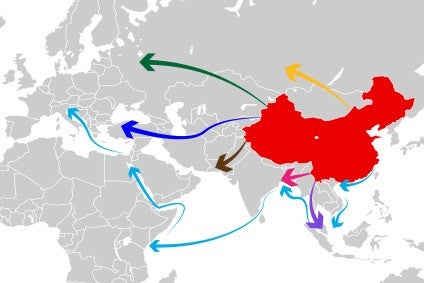
China’s clothing and footwear sectors are likely to be among the biggest beneficiaries of Beijing’s Belt and Road initiative (BRI), with its hubs and transport links opening up the supply chain to new markets and improving routes into existing ones.
Russia, Vietnam and Hong Kong will benefit from the improved supply network, offering Chinese companies the opportunity to increase their exports to these markets or enter them for the first time, according to new research from Fitch Solutions.
But it also suggests there will be opportunities to drive growth to smaller export partners such as Ethiopia and Uzbekistan as well as Hungary and Slovenia, all of which are all part of the BRI.
China’s President Xi Jinping first mooted the Belt and Road initiative in 2013, bringing together the Silk Road Economic Belt and the 21st-century Maritime Silk Road into one global trade and development initiative.
It links East Asia’s vibrant economic circle with the developed economies of Europe, and gives countries along the routes the chance to benefit from the initiative’s huge potential for economic growth.
The two routes are:

US Tariffs are shifting - will you react or anticipate?
Don’t let policy changes catch you off guard. Stay proactive with real-time data and expert analysis.
By GlobalData- Silk Road Economic Belt – Links China with the Persian Gulf and the Mediterranean Sea through Central and West Asia, connecting China with Southeast Asia, South Asia and the Indian Ocean.
- 21st-century Maritime Silk Road – From China’s coast to Europe through the South China Sea and the Indian Ocean in one route, and from China’s coast through the South China Sea to the South Pacific in the other.
According to Fitch Solutions, the BRI is approaching critical mass with 131 countries now participating in the initiative, up from 68 in 2017. China is also seeking to woo other key European powers including the UK, France and Germany.
The infrastructure built and upgraded as part of the BRI offers the potential for new markets to be reached, supply chains to be diversified and time and cost of trade to be reduced.
In particular, the credit and macro intelligence solutions provider believes the BRI holds some of the greatest opportunities for small and medium consumer goods manufacturers in China, as it will offer them access to new markets and with transport costs decreased will ensure they remain competitive.
This is especially important as Chinese economic growth cools and domestic manufacturers will need to look elsewhere for continued growth for their business.
Textile/clothing links
China is the largest manufacturer of clothing and footwear globally, with the country exporting US$193.3bn in 2018, almost a third of the world’s total clothing and footwear exports.
The country’s textile clothing sector is however under increasing pressure from other Asian nations, who offer cheaper labour. But the potential cost savings from more transport options and more reliable transport links via BRI will help offset some of the overall clothing manufacturing cost and can ensure that China retains its role as the key sourcing point for the fashion sector.
In addition, the top importers of textile raw materials from China are also South Asian countries (India, Bangladesh, Pakistan) or Southeast Asian countries (Philippines, Vietnam, Cambodia) along the routes.
Several transport projects have been developed or are in the process of being developed as part of the BRI in China’s key clothing manufacturing hubs – which will boost the connectivity of these hubs to export partners.
- Guangzhou-Shenzhen – Hong Kong Express Link: Connecting the clothing manufacturing hub in Guangzhou to Hong Kong, a key export destination for Chinese clothing and footwear.
- Incheon-Weihai Undersea Tunnel: Connecting Shandong province in China to Incheon, South Korea. Shandong province is close to the clothing manufacturing province of Jiangsu.
- Europe-Western China International Transit Corridor Project: Running from Lianyungang city in Jiangsu Province to St Petersburg, Russia.
- Moscow-Beijing High Speed Rail: Boosting connectivity between two major consumer bases and transport hubs.
Export growth options
In addition to growing China’s current top ten clothing and footwear export markets – US, Japan, Germany, Hong Kong, UK, Russia, South Korea, Vietnam, Netherlands and France – Fitch Solutions says the BRI also offers opportunities to drive clothing and footwear exports to smaller partners such as Ethiopia, Côte d’Ivoire, Uzbekistan, Hungary and Slovenia.
Ethiopia has witnessed the strongest growth out of this last group, with Chinese clothing and footwear imports up from US$253.6m in 2014 to US$538.5m in 2018.
Ethiopia is connected to the BRI through the railroad connecting the city of Addis Ababa to the port of Dijbouti. Dijbouti is part of the Maritime Silk Road, thereby offering connections to the ports in Guangzhou. In addition, the Mekelle Dry Port, Tigray, which is at the planning stage will improve logistics offerings further on the rail link.
For some countries along the route, however, there are risks as well as opportunities: Is China’s ‘Belt and Road’ a double-edged sword for Turkey?




